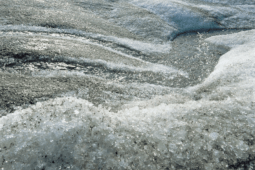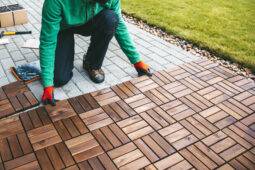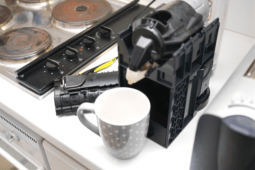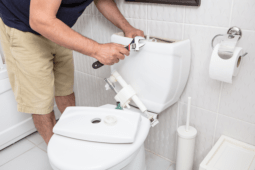Laminate vs Vinyl Flooring: Which Is Best for Your Home?
Choosing the right type of flooring can come down to a few factors. Chief among them is personal preference, but if you don’t really know where to begin, there are a few factors to consider. One of them is asking whether vinyl or laminate flooring is the right one for you.
In recent years, there has been a shift in popularity between the two. Vinyl flooring is the more popular option by more than a 2:1 ratio, commanding over 29% of the overall flooring market share. By comparison, laminate has around 12%. The reasons are that vinyl is more durable, easier to install, and provides better water resistance. Still, laminate has a higher-quality look in terms of style and appearance.
What is Laminate Flooring?
Laminate got its start back in 1984 thanks to the Swedish company Perstorp. They were the first to bring plastic laminate into the flooring world with their Pergo product. It came to North America sometime in the mid-1990s and had huge popularity because of its Euro design.
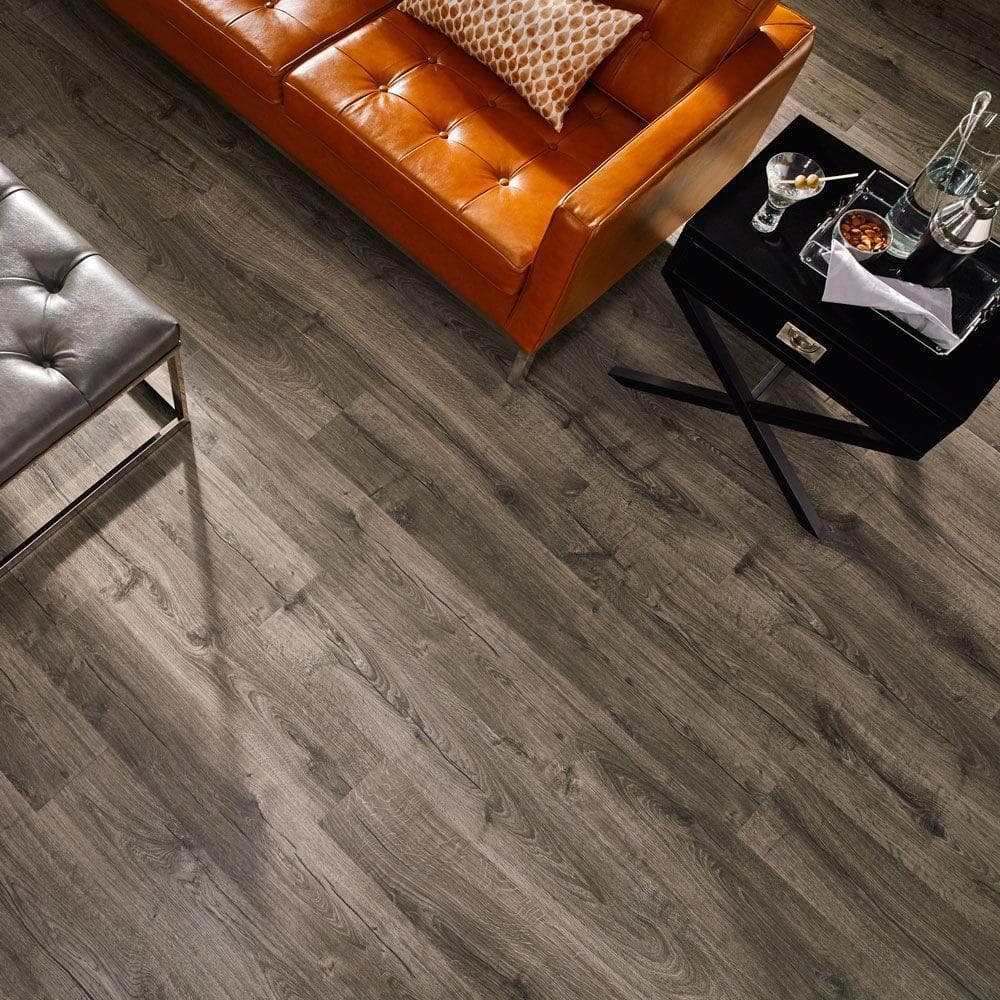
Today, laminate flooring is extremely common as there are a ton of manufacturers that make and sell this kind of flooring. Laminate flooring has four separate layers to it: the vinyl backing; the core that is made up of either medium density fiberboard (MDF) or a higher-density fiberboard (HDF); a layer for design that is similar in photographic pattern to something like wood or another natural material; and the transparent, durable “wear” layer.
It’s the core that defines laminate flooring. Each laminate flooring board is milled using a tongue and groove. This allows the laminate installers to snap each of the boards together easily, leaving the floor suspended securely over the subfloor without the need for it be physically attached. This is known as a floating floor.
Breaking Down the Layers of Laminate Flooring
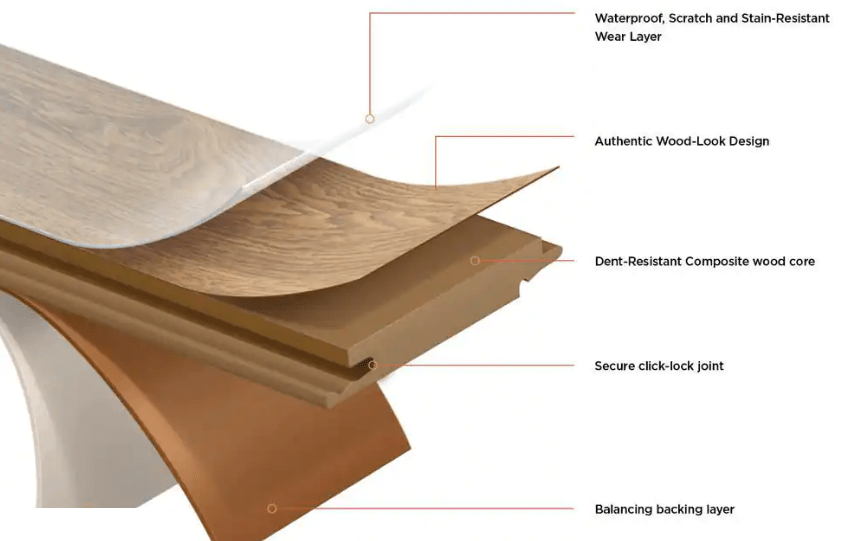
As covered briefly in the previous section, there are 4 layers that comprise a laminate flooring plank. Of course, that can vary slightly between manufacturers, but it’s a good rule of thumb when breaking down the construction of laminate flooring.
1) The Backing
Think of this as the backbone of the entire plank. The stabilization layer gives the plank the stability that it requires to not only hold up on its own but when matched up against the sup flooring that it will sit on. The backing layers also tend to be the second-thickest after the core, only slightly thicker than the decorative layer and the overlay or “wear layer.”
2) Base Layer
Next up is the base layer. This is 85% of the entire composition of the board. There are two varieties: high-density fiberboard (HDF) and medium-density fiberboard (MDF). It may go without saying, but the more high-quality laminate products out there come with an HDF core. HDF cores are more moisture-resistant, meaning you get far more options than in terms of use.
Check the price point. If you feel like you are getting a great deal on the laminate flooring that you are interested in, it’s likely because the base layer is comprised of MDF. While that is generally fine, keep MDF away from areas of more comprehensive moisture. That means that areas like mudrooms, laundry rooms, and basements are probably not a good fit.
3) Print Layer
The print layer is what most people notice about laminate flooring. That is because it’s the design itself. People tend to choose their flooring based on the design above all else and laminate flooring is no different.
The print layer on laminate is such that it tends to be a bit more photorealistic when compared to hardwood or natural stone. It can even include more of the natural-looking features of those materials like knots and scrapes that make it feel like the real thing.
This layer is very literally a photo, though it’s a high-res one. The better the laminate planks you find, the more realistic they can be in comparison to natural materials. If you want hardwood or natural stone and don’t want to shell out for it, then this is a fine alternative.
4) Wear Layer
Perhaps the thinnest of the layers but without a doubt the most important. The wear layer keeps the print layer protected. This is the main reason that 10 or 20 years from now, the laminate flooring that you purchase can look as it did the day you bought it. If that protective wear layer is damaged or compromised, it could lead to damage to one of the subsequent layers. All four layers are most susceptible to water damage above all else.
What is Vinyl Flooring?
Vinyl flooring has technically been around longer than most people think. This is because for years prior, sheet vinyl and vinyl composite tiles (VCT) were the only way that you could get vinyl flooring. That changed in the 1970s, however.
Manufacturers changed the entire vinyl flooring market thanks to the introduction of luxury vinyl planks (LVP) and luxury vinyl tiles (LVT). These had a lot more in common with laminate flooring than they did with VCTs or sheet vinyl.
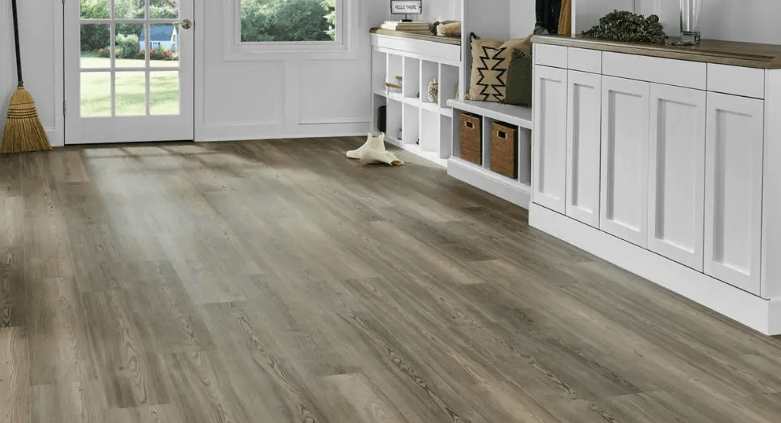
There are similarities between vinyl flooring and laminate boards (more on that later). Like laminate, LVP and LVT are constructed using similar layering methods. The layers of vinyl are the performance wear layer that covers the subsequent design layer; the core; and the backing.
Some of the earliest vinyl flooring cores were made of vinyl. Since then, the more contemporary offerings can be made of stone polymer composite (SPC) or wood polymer composite (WPC). Both offer better moisture resistance and a stronger rigidity than some of their predecessors.
Breaking Down the Layers of Vinyl Flooring
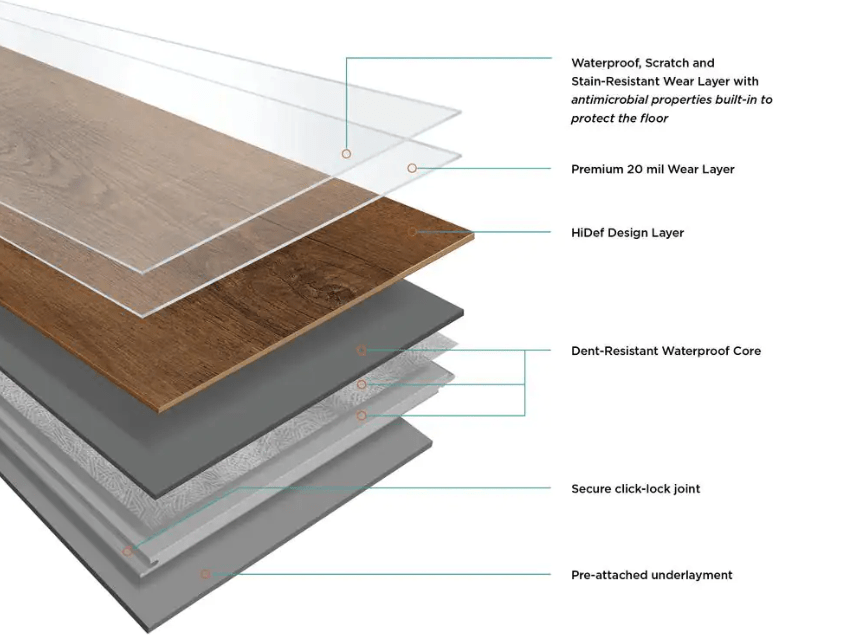
Just like laminate flooring, there are generally four layers to vinyl flooring planks, though that can change depending on the manufacturer. The construction is the same as the laminate planks with some subtle differences.
1) Backing
Just like with the laminate planks, the backing is essentially the backbone of the entire plank. Depending on the kind of planks that you buy, this may also be where the interlock system comes into play, allowing the planks to lock into place. For DIYers, this can mean an easy install that provides seamless locking and is perfect for any skill level.
2) Vinyl Core
This is the main difference between laminate and vinyl flooring planks. The solid vinyl core accounts for the vast majority of the board itself. Unlike laminate, vinyl is only made of a high-density core layer. That means it’s substantially more durable and moisture resistant than its counterpart. No matter where these boards are laid, they will hold up against anything.
3) Print Vinyl Layer
Similar to the laminate print, though with some differences. The photo imagery can make look vinyl look very similar in nature to those more natural materials like wood and stone. That said, vinyl tends to look a little less realistic when compared to laminate.
That said, technology continues to improve as does the photorealism of vinyl. There are options for leather, chevron, pebbles, hardwood, and so much more. Until recently, vinyl wasn’t able to produce designs that were as beautiful, realistic, or expensive as their laminate counterparts.
4) Wear Layer
The same as with laminate, this is the protective layer that goes on the top. it’s what keeps the flooring from suffering scratches, dents, and so much more. There are different layer thicknesses to choose from; the thicker the wear layer, the more durable it will be.
it’s important to note that the similarities in wear layer are quite negligible between the two. The main difference between vinyl and laminate flooring is that vinyl is basically waterproof. This has more to do with the core rather than the wear layer.
What are the Similarities Between Laminate and Vinyl Flooring?
It turns out that there are quite a few similarities when it comes to vinyl and laminate flooring. Both during the installation process and afterward, it can be pretty difficult to tell the difference between vinyl planks or tiles and laminate. Here are just a few of the similarities that the two share:
Appearance
What makes it tough to choose between the two is that, from an appearance standpoint, they are actually quite similar. Both offer very realistic depictions of stone, wood, and any other kind of natural material.
With more and more convincing depictions of each, it means being able to save versus natural materials. If push comes to shove, laminate is slightly higher quality in terms of design and appearance than viny. The embossing is more realistic to that of hand-scraped hardwood. Vinyl generally looks better on a thicker core of vinyl flooring.
The main difference in appearance has to do with the construction materials. Vinyl uses synthetic materials, things like PVC and fiberglass. it’s then embossed with the specific design before being finish using no-wax polyurethane.
Laminate, with a wood core, is sealed with a resin. The top layer, which is the one that gets walked on, has a transparent plastic layer that helps to protect against damage and wear and tear. Laminate is a little thicker, which tends to lead to better softness and warmth when standing on it
Costs
Making the decision even tougher is the fact that both laminate and vinyl flooring are pretty similar in cost. What makes them both appealing is that they are substantially cheaper than flooring materials like porcelain tile or hardwood. That said, vinyl can get more expensive at the higher end.
Laminate can generally be purchased for anywhere from $1 to $5 per square foot. What can make the price vary is the design that you choose and the thickness of the flooring materials. Vinyl will start at around $1 per square foot for the more simplistic glue-down sheet vinyl. Prices can get to around $5 per square foot when it comes to luxury vinyl planks. That said, high-end vinyl comes with a thicker layer for wear and a waterproof core for greater longevity.
Maintenance
Laminate flooring can be a little tricky to care for mostly due to the fact that it has limited moisture resistance. Using dry methods like a dry mop or a broom are generally recommended. If you do have to use a mop, make sure that it’s almost dry by the time it reaches the floor. Maintenance is otherwise pretty easy for laminate flooring.
Vinyl, on the other hand, is pretty easy to maintain and clean. You can use a mop and even scrub them using certain vinyl-safe cleaning products for the more stubborn spots that will pop up from time to time. Even better, vinyl can deal with other cleaning methods and requires basically nothing else otherwise to keep up appearances.
Dealing with stains is all too common, especially in kitchen areas. The good news is that no matter which material you chose, they both have great quality in their wear layers. Both have the properties needed to be effective in stain resistance, making it easier to clean and keep on top of. For families with pets or small children, in particular, there is no wrong answer when it comes to combatting stains.
Lifespan
Vinyl is known to be quite resilient and durable in the long run. Though it can be considered a lower quality since it’s at a low price point, vinyl has been known to hold up in even the most high-traffic of home areas for 20 years or more. It can depend on the level of care and maintenance, though some vinyl floors can show delamination with time.
Laminate is also very durable and strong. The one caveat is that it’s highly susceptible to water damage (see the maintenance section). Another caveat is that, should a scratch show up on the top layer, they more often than not can’t be repaired. That said, most laminate flooring can last anywhere from 10 to 25 years depending on the level of maintenance and care received.
What are the Differences Between Laminate and Vinyl Flooring?
Though they share a lot of similarities, including wear layers and a plastic design, there are distinct differences between them. The most notable is their resistance to water, their level of realism compared to natural materials, and the way that they are installed.
Installation
The good thing about either one of these materials is that installation is actually quite easy. For those who like to take on a DIY project or two, it can make for a great installation option.
Laminate primarily uses click-and-lock installation. Basically, it means that the planks get fitted into an adjoining groove on the next plank. When they lock together, the seam is closed and the pieces are connected. For this reason, laminate flooring is considered to be “floating”, because they go over the existing subfloor without actually adhering to the floor.
Vinyl, on the other hand, offers a few different installation methods. They also come in click-and-lock planks, but they can be glued down, and even come with peel-and-stick options as well. Going with sheet vinyl is a little more difficult because it’s heavier and it requires more precise cutting around angles and shapes in the room. If you want to go with sheet vinyl, consider a professional.
Water Resistance
If there were one singular difference to describe what separates vinyl flooring from laminate flooring, it would be the water resistance level. This is the area in which vinyl is the clear winner between the two.
Vinyl is highly resistant to water. Most modern vinyl floors are made using 100% polymer materials. That means that they can hold up to serious moisture without any change in quality. Vinyl can be submerged, dried out, and then reused without any change in quality. Not only that, vinyl sheets can be installed for a whole room, which means that there are no seams for the water to leak through to the subfloor.
On the other hand, laminate has a far more limited moisture resistance. it’s made up of a fiberboard core for most laminate products. These cores are much more susceptible to things like softening or swelling when exposed to moisture for any prolonged period of time. The center, when waterlogged, can cause the top layers to start to peel away. It might not be ideal to have laminate flooring in laundry rooms or family bathrooms where there is a higher moisture prevalence.
Appearance and Realism
Though both types of flooring are quite similar in their appearance, there are some subtleties that can make a difference. Generally speaking, both do a good job of mimicking the look of natural materials like wood and stone.
That said, laminate tends to do a better job of matching up to those natural materials. For instance, the smooth, flat surface of laminate tends to more closely match hardwood than vinyl would. The latter has a more textured surface that can come off looking more artificial.
For the cost and ease of installation, both are more than passable compared to their natural counterparts. But if you are going for something that has a more realistic look to it, then laminate would be the way to go.
Other Important Factors to Consider
Generally speaking, there are a few important factors to choose from when it comes to flooring. Cost tends to be the highest on the list because not everyone has an unlimited budget. Being able to stay within those limitations is crucial to the project.
After that, there is a matter of design. When laying down flooring as part of a greater renovation, it can mean a little more freedom in design. But if you are trying to match up the design of your flooring, something like vinyl (which has a plethora of options to choose from) may be a better fit.
After that, the ease of installation and maintenance matters as well. Even for experienced DIYers who can install the flooring with little issue, the last thing they want to do is to have to spend a ton of time cleaning and maintaining it.
Finally, there is durability to consider. This can vary depending on where you plan to do the installation. It has been covered that vinyl tends to do better in areas of higher moisture that could cause the laminate to lift and split.
That said, there are a few additional factors worth considering when making your decision between vinyl and laminate flooring.
Environmental Impact
This one depends on the person. That said, more and more buyers are seeing the benefits of having a positive environmental impact. We can all do our part to make the world a better place.
This brings us to the environmental impact that both have to offer. The difference between vinyl and laminate has changed a bit over the years. This has to do partially with advancements in technology as well as directives for companies to use recyclable materials where possible.
Vinyl flooring has become more efficient or “green” over the last several years. Some vinyl flooring manufacturers even offer products that achieve the LEED credit EQ4.3 which is for low-emitting materials.
The downside from an environmental standpoint is that vinyl still uses a synthetic material that, when burned, is known to produce toxic materials. Not only that, but vinyl doesn’t decompose when it winds up in a landfill and recycling vinyl is generally not an option.
There are a variety of laminate manufacturers that offer products that qualify for a status known as LEED MR4 which means it has recycled content. That said, most laminate still uses a plastic layer for the surface. It also makes use of melamine resins when creating the core level. Those resins are not considered green since they can potentially be off-gas chemicals.
When push comes to shove, laminate is the preferable option if you are trying to go green. This is due to the natural wood that you would find in the fiberboard core. But if being green really matters, then neither option is particularly great for the environment. Not in the way that something more natural like linoleum, natural wood, or even bamboo flooring would be.
Resale Value
Let’s take a look at this from a different perspective. Instead of trying to pick out flooring that you would find appealing, what if you intend to sell the home? Thinking like buyers is one of the most important things that you can do when trying to sell a home. So, it only stands to reason that you would want to choose the type of flooring that could deliver the best bang for buck in terms of return.
Though not as popular as vinyl, that doesn’t mean that laminate can’t add value to a home. The caveat is that it has to be in good condition and relatively new. Older laminate can look less attractive and take away from the value of the home.
Vinyl, on the other hand, is considered the preferred option among the two. There are major brands of luxury vinyl plank flooring that can give you pretty solid resale value for a home. That said, if you go with something cheaper, it can be seen by buyers as a sort of “project-in-waiting” when they have closed on the house and can do what they please.
You really can’t go wrong with either laminate or vinyl because they are so comparable in quality. While neither brings quite the level of love and prestige that others like engineered hardwood, solid hardwood, natural stone, or designer ceramic tiles do, they are far from the worst option. Just make sure that if you go vinyl or laminate, you choose a higher-quality option that won’t put off any potential buyers.
Sound and Comfort
Though it may seem like most flooring generally feels and sounds the same, there can be discernable differences. No matter what kind of flooring you go with, it should feel comfortable to walk on without being unnecessarily loud.
Vinyl can run the gamut. They can be hard and cold with the thinner layers or warm and comfortable with a thicker layer. It also depends on where they are installed. If you have them covering basement flooring, they will likely feel cold and harder than they would on other types of subflooring.
Laminate is interesting in that it doesn’t feel like wood but it does have a certain warm feeling to it. This is especially true when laminate is paired with an underlayment of premium quality. Because there is a hollowness to them (since they are not directly attached to the subflooring), they tend to be more comfortable and quieter. Laminate also has the option of pairing with a felt or foam underlayment which can make it even softer, quieter and more comfortable to walk on.
When Might Vinyl be a Better Choice?
This is a comparison of the two, so it helps to know which direction to go in. When making the choice between vinyl and laminate, there are a number of factors to consider. Location of the area, level of moisture, and the level of traffic or general wear and tear that the floor will face.
Though vinyl has the downside of not looking quite as realistic or authentic in its appearance, there are a lot of things to like. Each of these factors can make vinyl a much better choice than laminate when it comes to your home.
The first thing that makes vinyl a better choice is its superior resistance to moisture. Laminate has poor resistance to moisture, which makes it less than ideal to go in mudrooms, laundry rooms, bathrooms, or basements. Vinyl plank flooring, on the other hand, can go just about anywhere because it’s exceptional at standing up to moisture. Even when submerged, it holds up better than laminate flooring does.
There is a benefit for those with pets. Because the surface of most vinyl flooring has a little more give to it, it’s easier for pets to navigate. That’s not even mentioning the fact that vinyl is pretty good about holding up to stains. For homes that have pets, especially multiple pets, vinyl would make a lot more sense than laminate.
From an installation standpoint, there is a major benefit for those who enjoy taking on a DIY project. Though the click-and-lock installation of laminate is pretty easy, in order to cut laminate it has to be cut with a saw. Vinyl, on the other hand, can be cut with a knife, making it a quicker cut and easier to use for the DIYers out there.
Finally, there is the matter of variance of design. Laminate has more than a few offerings, but it can’t hold a candle to the different design varieties that vinyl comes in. If you are looking to match current décor or are trying to make a real statement design, going with vinyl will provide far more selection than laminate.
When Might Laminate be a Better Choice?
Since laminate is pretty much plastic, it’s a bit more pliable and the surface of laminate flooring looks way more like wood. For homeowners that are looking to achieve a low-cost alternative to natural hardwood, then laminate is definitely the way to go.
Laminate tends to work best in the areas of the home that don’t generally deal with a lot of moisture (more on that later). It also has a slight edge on vinyl because it’s more eco-conscious. The majority of laminate flooring brands are manufactured using only recycled materials. That isn’t even mentioning the fact that laminate has a wood-based core that will decompose if it goes into a landfill.
Also, there is a potentially greater level of comfort to be had with laminate. Depending on the kind of underlayment, laminate can feel softer to the touch and also be quite a bit quieter than vinyl. For living areas and bedrooms in particular, that would give laminate the edge.
In most cases, you can get away with using either unless it’s an area that has a higher moisture content. The last thing you want is to install laminate only for it to warp, peel away, and wear down far faster than another material would in a similar setting.
Which Flooring is Best Based on the Room?
Now that we have a thorough understanding of each type of flooring, let’s take a look at the different areas of the home. This can provide some clarity as to where one type of flooring may do better than another. If you are looking for continuity throughout the home, then it may be worth it to go with vinyl on the whole.
As covered throughout this guide, moisture is a major issue for laminate flooring. It tends to split, peel and is otherwise damaged by prolonged exposure to moisture. If there is flooding of any kind, it can mean that your laminate flooring is totally ruined and needs to be replaced.
This means that there are a few rooms where you should definitely not have laminate flooring and a few others where it’s a maybe at best. For mudrooms, bathrooms, and basements, it’s inadvisable to use laminate flooring. Those are areas with a higher concentration of moisture and are susceptible to damage.
You might be able to get away with laminate in kitchen or powder rooms but that can be dicey at best. It depends on a few different factors and for a place like a kitchen, cleaning will have to be done with dry products to avoid doing damage to the laminate.
When it comes to vinyl, though, there are no reservations. It can be used in any room of the home, even areas like the basement or mudroom where there is a heavier concentration of moisture. Not only will vinyl hold up without damage to the underlying core, but it will also continue to look good.
Which is the Best Choice Overall?
The choice between laminate and vinyl is a close one in nearly every aspect. There are some discerning factors that can make the choice a little easier, though. When you get into the higher-end laminate and vinyl flooring options, the differences become even more minute.
On the whole, vinyl is the better option for two reasons. The first is that there are more design options and styles to choose from than what laminate has to offer. This means being able to match current design aesthetics, whether your own or something that is popular and may sell well.
The second is the waterproof factor. Though laminate will do fine in areas where there isn’t a lot of moisture, that can be limiting. Vinyl, meanwhile, can go in any room in the house. Mudrooms, kitchens, bathrooms, and even basements can all have vinyl flooring because they are built to hold up against water, even when submerged.
After that, things get pretty granular. Laminate is a little more comfortable to walk on while vinyl provides more installation options. It can go back and forth just as easily. The truth is that you can’t go wrong with either in most cases.


